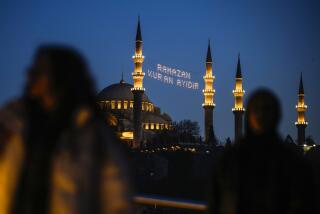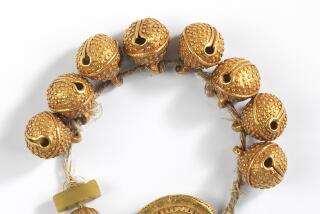Column: Before Islamic State: The Getty acquires earliest photos ever taken of ancient Palmyra
In recent weeks, the world has watched helplessly as members of Islamic State have laid waste to millennia-old temples at the ancient ruins site of Palmyra in Syria. All of this makes a cache of early photographs acquired by the Getty Research Institute (GRI) that much more valuable.
On Thursday, the institute announced the addition of almost four dozen 19th century photographs to its collection, a number of which depict the graceful ruins of Palmyra, an ancient city that was once a crucial Silk Road hub. The images represent the earliest photographs ever taken of the site.
In a blog post about the acquisition, Frances Terpak, the institute’s curator of photography, states that “these photographs represent rare primary documents of a region and World Heritage Site in crisis, preserving the memory of its ancient monuments and natural beauty for posterity.”
SIGN UP for the free Essential Arts & Culture newsletter >>
The images were taken by French naval officer Louis Vignes during his journey through the area in 1864. Vignes was trained in photography by the renowned Charles Nègre, an early pioneer in the form. And it was Nègre who created the extraordinarily well-preserved prints — which capture Palmyra’s remarkable architecture.
A UNESCO World Heritage site, Palmyra is the vestige of a more-than 2,000-year-old settlement that brought East and West together. It’s architecture bears Classical influences, from when the city was part of the ancient Roman Empire, but it also has traces of Chinese, Indian and Semitic styles. If ever there was a monument to multiculturalism, this is it. Unfortunately, Islamic State militants regard the site (and so many others) as idolatrous and have set about blowing up its majestic temples, monuments and tombs.
The photographic cache acquired by the Getty also includes Vignes’ photographs of Beirut, taken during the same expedition. These capture various panoramas of the city, which in the 19th century was one of the region’s most important ports and trading hubs.
The acquisitions join other important documents and images in the institute’s collection that chronicle the region and its history. This includes a cache of images from the archives of the Duke of Luynes, the French art collector who financed Vignes’ expedition, as well as early publications on Palmyra, such as Abednego Seller’s 1696 book, “The Antiquities of Palmyra.”
Read more about the acquisition on the Getty’s blog.
Find me on Twitter @cmonstah.
MORE:
New images of Islamic State destruction at Palmyra show extent of ‘atrocity-class event’
What will become of Palmyra ruins after Islamic State killing of Syrian archaeologist?
Islamic State reported to destroy historic tombs in ancient city of Palmyra, Syria
More to Read
The biggest entertainment stories
Get our big stories about Hollywood, film, television, music, arts, culture and more right in your inbox as soon as they publish.
You may occasionally receive promotional content from the Los Angeles Times.







